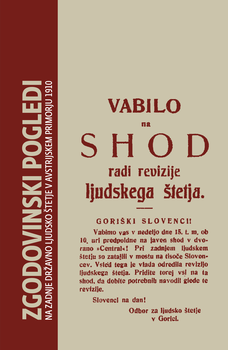Zgodovinski pogledi na zadnje državno ljudsko štetje v Avstrijskem primorju 1910. Jezik, narodnost, meja
Habsburška monarhija je prvo moderno uradno štetje prebivalstva izvedla leta 1857. Od leta 1869 dalje so popise izvajali vsakih deset let s kritičnim datumom 31. december. Štetja so popisovala prisotno prebivalstvo. Od leta 1880 so popisi vsebovali tudi rubriko o občevalnem/pogovornem jeziku. Tako je bilo mogoče poslej ugotavljati narodnostno sestavo prebivalstva v državi, čeprav tako formulirano vprašanje ni dajalo natančnih rezultatov. Slovenci in drugi slovanski narodi v monarhiji so zlasti pred štetjem leta 1910 zahtevali ukinitev rubrike občevalni jezik (lingua d'uso, Umgangssprache) in uvedbo nove rubrike o narodnosti ali o maternem jeziku. Zadnje avstrijsko ljudsko štetje iz leta 1910 je značilen in pomemben dogodek iz politične zgodovine Slovencev v Avstrijskem Primorju. Značilen je zaradi ravnanja mestnih oblasti, ki so štetje izvajale. Pomemben je zato, ker prestavlja politično zmago slovanskega prebivalstva, saj je oblast zaradi ugotovljenih nepravilnosti odredila revizijo štetja. Štetje leta 1910 je služilo tako jugoslovanski kot italijanski strani za dokazno gradivo ob postavljanju ozemeljskih zahtev pri mirovnih pogajanjih po prvi in po drugi svetovni vojni.
Prenosi

Zbirka
Licenca

To delo je licencirano pod Creative Commons Priznanje avtorstva-Nekomercialno-Brez predelav 4.0 mednarodno licenco.
